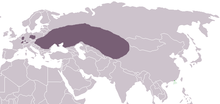- European Hamster
-
European Hamster 
Conservation status Scientific classification Kingdom: Animalia Phylum: Chordata Class: Mammalia Order: Rodentia Family: Cricetidae Subfamily: Cricetinae Genus: Cricetus
Leske, 1779Species: C. cricetus Binomial name Cricetus cricetus
(Linnaeus, 1758)
European Hamster range The European Hamster, Cricetus cricetus, also known as the Black-bellied Hamster or Common Hamster, is a hamster which is the only species of the genus Cricetus. It is native to a large global range, extending from western Europe, through central and eastern Europe, Russia, and Kazakhstan, reaching as far east as the Yenisey river. The animal is widely considered a farmland pest, and has also been trapped for its fur. Across its global range it is considered of least concern but in many individual European countries it is considered critically endangered.
Contents
Description
The European hamster has brown dorsal fur with white patches. The chest and belly are black. The tail is short and furred. It is much larger than the Syrian or dwarf hamsters which are commonly kept as pets. It weighs 220-460 g (8-16 ounces) and can grow to 20–35 cm (8-14 inches) long with a tail of 40–60 mm (1.5-2.3 inches). Its dental formula is 1/1, 0/0, 0/0, 3/3.
Behavior
The Common Hamster is a nocturnal or crepuscular species. It lives singly but in a complex burrow system. It eats seeds, legumes, root vegetables and grasses and also insects. It transports its food in its elastic cheek pouches to the food storage chambers. These may be quite large and may consist of a total of 65g of food including 50g of potatoes and 15g of grain[1] It hibernates between October and March. During this time it wakes every five to seven days to feed from the storage chambers. The adults reach sexual maturity when they are about 43 days old and breed from early April to August. The gestation period is 18–20 days and the size of the litter ranges from 3–15 young which are weaned when aged three weeks.[1]
Distribution
It is typically found in low-lying farmland with soft loam or loess soils, although it may also inhabit meadows, gardens or hedges. It is found from Belgium (e.g. Bertem where there is a population) and Alsace in the west, to Russia in the east, and Romania in the south.
In captivity, the European hamster has an unusually long lifespan, living up to eight years.
The Court of Justice in Luxembourg, the European Union’s highest court, ruled June 9th 2011 that France had failed to protect the European hamster. The court said that if France does not adjust its agricultural and urbanization policies sufficiently to protect it, the government will be subject to fines of as much as $24.6 million.[2]
References
- ^ a b MacDonald, David; Priscilla Barret (1993). Mammals of Britain & Europe. 1. London: HarperCollins. pp. 236–237. ISBN 0002197790.
- ^ Erlanger, Steven (9 June 2011). "France Is Scolded Over Care of Great Hamster of Alsace - NYTimes.com". The New York Times (New York: NYTC). ISSN 0362-4331. http://www.nytimes.com/2011/06/10/world/europe/10hamsters.html. Retrieved 10 June 2011.
Species of hamsters (subfamily Cricetinae) Allocricetulus Cansumys Cricetulus Cricetus Common (Cricetus cricetus)Mesocricetus Phodopus Tscherskia Categories:- IUCN Red List least concern species
- Hamsters
- Mammals of Europe
- Monotypic mammal genera
- Animals described in 1758
Wikimedia Foundation. 2010.

